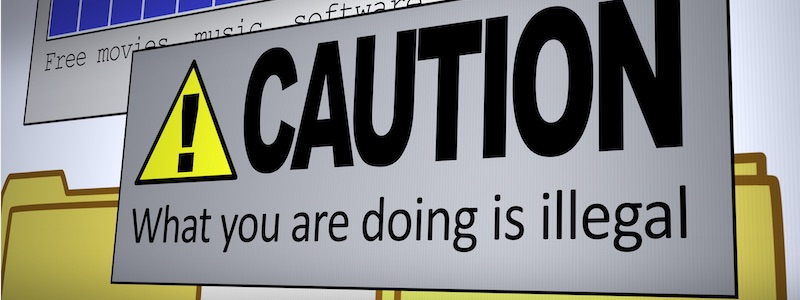
Product descriptions, product photos, blog posts: All are automatically copyrighted in the U.S. Using them without permission is illegal and subject to large penalties.
Copyright infringement is a serious issue that could cost a business as much as $150,000 per instance. If your business receives an infringement notice, take it seriously. Aim to settle if, in fact, infringement occurred.
Copyright infringement happens when a business copies or misuses material protected under copyright law, such as a photograph or a product description. That business is an infringer and has diminished the original creator’s property in some way.
Infringement Examples
Let’s consider three, ecommerce-related copyright infringement scenarios.
Product descriptions. A small, online toy seller in Idaho, Labrador Toys, carries a line of figurines from Papo, a French toymaker. The manufacturer’s product descriptions are a little dry, and they show up across the internet on many toy-related websites — from Amazon and Walmart to small sellers.
So Labrador Toys hires a real poet to compose original, witty product descriptions for each of the Papo figures it sells.
Sometime later, an ecommerce drop-shipping business decides to start carrying Papo figures. The business owner hires his high-school-aged niece to write product descriptions. She finds Labrador Toys and copies the Papo product descriptions, changing a few words for good measure.
This is a clear infringement. The descriptions are automatically copyrighted in the U.S. Moreover, if Labrador Toys had registered the product descriptions, the penalty for willful infringement would be set by statute at $150,000 per instance. If a court decided the infringement was not willful, the statute allows for between $750 and $30,000 per instance as a remedy.
Product photography. Next, imagine a boutique clothing store called Shelly’s Fabulous Fashion. The company has been operating a brick-and-mortar store for years. Shelly has now decided to start selling online.
There is one problem. Most manufacturer-supplied product images are faceless. To avoid paying model royalties, clothing makers often “cut the heads off” of product images. This won’t do for Shelly.
An example of a “headless” model from Carhartt. Many clothing manufacturers supply only product photos with some portion of the head cut off.
She hires a photographer and a beautiful, fit model to get unique product shots, head included.
A few states away, another established brick-and-mortar retailer has decided to start selling online. The company has assigned to Becky, a marketing intern, the task of tracking down product descriptions and images.
Becky called the clothing makers and struggled to download large TIFF images from an unhelpful Scene7 site. In desperation, she finds Shelly’s Fabulous Fashion online and copies the photos. Thus, Becky willfully infringes on the copyright.
Lifestyle images. Jen is a seasoned marketer responsible for the blogs, podcasts, and social media channels of an omnichannel retailer. As part of her content marketing plan, she has hired a certified master gardener to write a weekly how-to article.
The gardener often takes her own photos. But one article about how to grow better carrots only included pictures of dirt. Jen heads to the internet and finds a stock photography website where she pays $75 for a compelling photo of garden-fresh carrots.
Three years later, Jen receives a notice from an unfamiliar stock photography website that a photo’s license will expire next month and must be renewed or removed. She’s busy and doesn’t know what it means. She ignores it.
A copyright infringement notice follows.
Responding to an Infringement Notice
First, verify that your business did infringe. Read the infringement notice carefully. Investigate whether your business misused copyrighted materials.
Here are some things to check:
- Was the material used with permission?
- Did your company hold a license under another name?
- Is one of your employees listed as the license holder?
- Was the license in a manufacturer’s or designer’s name?
- Is the material elsewhere on the web under a different license?
- Is the material copyrightable?
It is also important to try to discover how an infringement occurred. There is a significant difference in the examples above between Jen, the seasoned marketer, and Becky, the intern.
Jen originally paid for a license and misunderstand its scope. But Becky willfully stole the image, using it for her company without permission.
Next, plan your response. In most cases, if your company actually infringed on copyrighted material, it is going to cost money. This expense could take one of three forms.
- Pay the amount demanded in the infringement notice.
- Explain how the infringement occurred and settle for a lesser amount.
- Go to court and face a remedy of up to $150,000 per instance.
The United States requires that a work be registered before its creator can sue in federal court. The U.S. Supreme Court noted this in Fourth Estate Public Benefit Corp. v. Wall-Street.com, a recent case.
“So, if someone uses product photo or the text of a website without authorization, and then refuses to stop or compensate the copyright owner, then the copyright owner must file a copyright application and wait for it to register prior to filing a copyright infringement lawsuit,” said Joseph A. Mandour, a San Diego-based intellectual property attorney.
Failure by the owner to register material doesn’t let the infringer off the hook. It still may still make more sense to settle.
Copyright Resources
We’ve addressed copyright matters over the years. Here are links some of our posts.